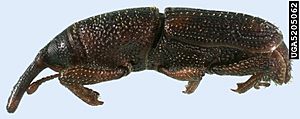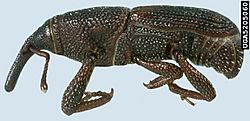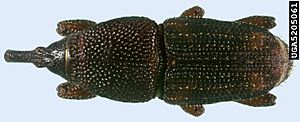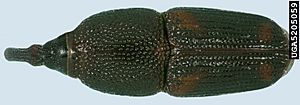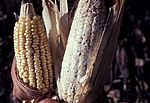Maize weevil facts for kids
Quick facts for kids Maize weevil |
|
|---|---|
 |
|
| Scientific classification | |
| Kingdom: | |
| Phylum: | |
| Class: | |
| Order: | |
| Family: | |
| Genus: | |
| Species: |
S. zeamais
|
| Binomial name | |
| Sitophilus zeamais (Motschulsky), 1855
|
|
The maize weevil (Sitophilus zeamais) is a species of beetle in the family Curculionidae. In the United States, it is called the greater rice weevil. It lives in many tropical areas around the world, and in the United States. It is a major pest of maize. This species attacks both crops that are still growing and those that have been harvested. It attacks wheat, rice, sorghum, oats, barley, rye, buckwheat, peas, and cottonseed. The maize weevil also attacks processed cereal products such as pasta, cassava, and various coarse, milled grains. It has even been known to attack fruit while in storage, such as apples.
Description
A close relative of the rice weevil, the maize weevil has a length of 2.5 mm to 4 mm. This small, brown weevil has four reddish-brown spots on the wing covers (elytra). It has a long, thin snout, and elbowed antennae. Sitophilus zeamais appears similar to the rice weevil (Sitophilus oryzae), but has more clearly marked spots on the wing covers, and is somewhat larger. It is able to fly.
Although the maize weevil and rice weevil do look alike, and are easily confused with one another, there are several distinguishing features:
| Maize weevil (S. zeamais) | Rice weevil (S. oryzae) |
|---|---|
| Circular punctures on pronotal dorsum | Longitudinally elliptical punctures on pronotal dorsum |
| Pronotal punctures have no median puncture-free area and are nearly equally spaced apart | Pronotal punctures are separated by a flat, median, longitudinal puncture-free zone |
| More than 20 pronotal punctures along the approximate midline, running from neck to scutellum | Less than 20 pronotal punctures along the approximate midline, running from neck to scutellum |
| Scutellar elevations relatively farther apart compared to their longitudinal length | Scutellar elevations relatively closer together compare to their longitudinal length |
| Scutellar elevations extend longitudinally approximately halfway down the scutellum | Scutellar elevations extend longitudinally approximately more than halfway down the scutellum |
| Proepimera meets behind the forecasting coxae and has a barely discernible notch along the posterior edge at the site of the meeting
point |
Proepimera meets behind the fore coxae and along the posterior edge, has a distinct curved notch |
| Aedeagus has two dorsal, longitudinal grooves | Aedeagus (in males) is smooth and shiny on the dorsal surface |
Distribution
S. zeamais occurs throughout warm, humid regions around the world, especially in locations where maize is grown, including: Polynesia, Argentina, Brazil, Burma, Cambodia, Greece, Japan, Morocco, Spain, Syria, Turkey, United States, USSR, Sub Saharan Africa and Yugoslavia. It is also widely distributed throughout agricultural areas of northern Australia. This species has also been recorded in Canada, in the provinces of Ontario and Quebec, and has been intercepted at ports, but is not well established there. It has, however, been present for several years in Montreal, where grain from the U.S. is stored.
Life cycle
The complete development time for the life cycle of this species averages 36 days. The female chews through the surface of the grain, creating a hole. She then deposits a small oval white egg, and covers the hole as the ovipositor is removed, with a waxy secretion that creates a plug. The plug quickly hardens, and leaves a small raised area on the seed surface. This provides the only visible evidence that the kernel is infested. Only one egg is laid inside each grain. When the egg hatches into a white, legless grub, it will remain inside and begin feeding on the grain. The larvae will pupate while inside, then chew a circular exit hole, and emerge as an adult beetle. A single female may lay 300 to 400 eggs during her lifetime. Adults can live for 5 to 8 months. Breeding conditions require temperatures between 15 and 34 °C and 40% relative humidity.
When the adults emerge, the females move to a high surface and release sex pheromones. Males are then attracted to this pheromone.
Host range
The maize weevil commonly attacks standing crops, in particular, maize before harvest, and is also commonly associated with rice. It infests raw or processed cereals such as wheat, oats, barley, sorghum, rye and buckwheat. It can breed in crops with a moisture content of a much wider range than S. oryzae, and has been found in fruit, such as apples during storage. Although the maize weevil cannot readily breed in finely processed grains, it can easily breed in products such as macaroni and noodles, and milled cereals that have been exposed to excessive moisture.
Damage and detection
Early detection of infestation is difficult. As S. zeamais larvae feed on the interior of individual grains, often leaving only the hulls, a flour-like grain dust, mixed with frass is evident. Infested grains contain holes through which adults have emerged. A possible indication of infestation is grain, when placed in water, floating to the surface. Ragged holes in individual grains, similar to damage caused by the rice weevil and granary weevil, may indicate infestation. In large stores of grain, an increase in temperature may be detected. The most obvious sign of infestation is the emergence of adults.
See also
 In Spanish: Sitophilus zeamais para niños
In Spanish: Sitophilus zeamais para niños


